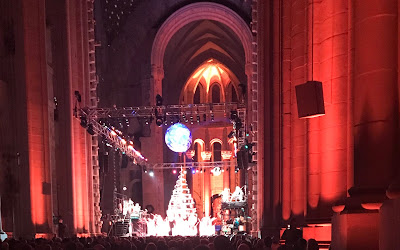Paul Winter’s 39th Annual Winter Solstice
Celebration
December 22, 2018, Cathedral of St. John the Divine,
NYC
Photos by John Pietaro
by John Pietaro
I couldn’t bring myself to dub this piece
a review. Sure, I carried my journal and pen, but I wasn’t there to simply cover
it. Getting to Paul Winter’s solstice event had been a goal for decades, but
somehow always missed. Somehow, and I’ve lived in New York my entire life. This
year was different.
Hurriedly walking east on 112th Street,
still twisted up within from crawling in traffic since Brooklyn, the wife and I
made our way to the Cathedral. I hadn’t gotten a good look at St. John the
Divine since its scaffolding came down a few years back, repairs complete. By
the time we hit Amsterdam Avenue, the grand façade pridefully displayed itself.
A gothic haven, mystic but never beyond reproach.
We took the stairs and entered, trying to
seek out general admission seats not tooooo far back. We were semi-successful (no,
I was not there on assignment and wouldn’t use my press card to snare a closer
view). No matter that, the room itself, with its ceiling of massive heights,
sang to us just as personally as the front rows. As a firmly unreligious sort,
somewhat unspiritual too, settling into this church with the warm welcome of candles
flickering over plain wax, everything made more sense. I carefully scanned the
stone walls, the breathtaking architecture, the large banners proclaiming messages
of (actual) unity and unashamed social justice.
The lights dowsed, and Paul Winter’s
soprano saxophone resonated suddenly across the Cathedral. A thin blue
spotlight directed all eyes to the high, small balcony well behind us; there
stood Winter offering his lyric call. It echoed through the house and every
chest cavity within, clarion. This led to an all-encompassing solo statement by
Jeff Holmes, the Winter Consort’s new pianist, from his perch onstage. Next, the
presence of organist Tim Brumfield became dramatically evident as his deft
touch on the church’s aeolian pipe organ usurped the space and the ground
beneath. By the time
drummer-percussionist Jamey Haddad launched into his own solo segment—thunderous
and whispering all at the same time—Winter had made his way to front and
center, flanked by the Consort on varying levels of lifts. Above Haddad’s lift
was that of cellist Eugene Friesen, long-term Consort member with his own
amazing performance resume. Bassist Eliot Wadopian stood nearby Holmes’
keyboards and the celebrated woodwind master Paul McCandless sat to his left,
armed with English horn, bass clarinet and a history that includes Oregon and the
first Consort before that (it seems strangely unjust that this noted
instrumentalist was not acknowledged by Winter until the close of the evening).
In the darkened space, lit only by the
stage which glowed 2/3 of the long way across from us, and the golden-white sparkle
of candles, taking notes become impossible. Before the 3-hour show’s
intermission, Winter and company were joined by the gifted voice of Theresa Thomason,
who encompassed a soulful blend of Mavis Staples, Aretha Franklin and Mariah
Carey, probably others who don’t come to mind just now. One hears the church in
Thomason as clear as it is in the best of R&B, but that only helped realize
the mission of this particular house of worship, one welcoming every religion,
as they all should. And then without warning, the sound of African drums,
djembe and conga, mostly, craned up from the rear, accompanying and guiding the
Forces of Nature Dance Theatre as the entire troupe glided toward the stage.
The crowd, for the umpteenth time, erupted in a wild applause.
Other highlights included the emergence of
the Solstice Tree, it cast of spiraling metal—the very imagery of the ancient
Spiral Goddess--decorated by multiple gongs and bells. A traditional clog
dancer, depicting a sprite, celebrated it’s being, borne of the oldest
religion. For the first time in a long time, I experienced an utter spiritual welcoming.
This was only made stronger by Matt Guyon’s striking of the giant sun gong, aloft
in the tower. Each stroke of it, a quake.
And during the nightfall epic, the
solstice itself, the longest night of the year, was represented as the crowd faded
into a mystical darkling. Very, very slowly we were coaxed into the imagery of
daybreak, closing with a soaring crescendo over softened waves of melody.
Overall the sheer power of s o u n d was on display throughout the
evening, both as a force of spirituality and as one unto itself. As the lighted
globe made its way to the front and then rose above us all, Paul Winter reveled
in the song of a forlorn wolf, offering responses through his horn which sang
to the ages.















